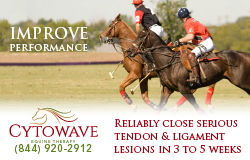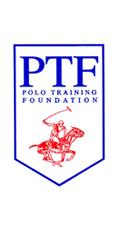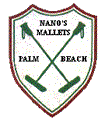One year after sustaining a serious injury while playing a practice match, Kelly Beck is back on the polo field enjoying the sport she and her family have
come to love.
The daughter of a classical violinist,
Kelly’s only involvement with horses
growing up was as a member of the pony
club. It was not until she was an adult
that she got more involved with horses.
She and her husband Michael bought a
horse when the kids were younger and
eventually purchased a farm and built an
eventing barn in Tallahassee, Florida.
Busy homeschooling her six children,
Kelly did not have time to be too involved
with the horses. Her oldest son Daniel
rode with a hunter/jumper barn until he
confided to his mother it was as exciting
as being in a sewing club. When she
brought him to a polo game, he was
intrigued. After giving polo a try, he
started taking regular lessons with Stuart
Campbell. He was soon hooked and
before long he had his own string of polo
ponies.
When he went off to college, his string
was just sitting there. With the kids
getting older and more independent,
Kelly had more time, so friends suggested
she give polo a try. She found it to be a
great joy. Soon her other kids decided to
join in, though she admits her husband
was the last holdout. “He finally said
well, if you can’t lick ‘em, join ‘em, so he
started playing too.”
Today, 12 years after Daniel took his
first lesson, the family owns 80 polo
ponies and the entire family enjoys
playing polo.
"We started with an eventing barn
then kind of moved sideways into polo.
But I will say this; I am so glad we did!
Besides being such a great physical
activity, polo is also so much more a
family sport,” explains Kelly. “It is one
you can all enjoy together, even playing
different levels. You are working with a
team, it is not every man for himself. And
if you are going to be spending so much
time on an activity, at least with polo you
can do it together, as a family!
It gives me great joy. I love that it’s a
family sport. We went from 0 to 60! It is
a great lifestyle and it offers a great
balance with physical [activities].”
The family owns a regulation polo
field in northern Florida and is based at
the Sarasota Polo Club in the winter. They have also played at The Villages, as
well as taking summer polo trips to
places like Wyoming; Lexington,
Kentucky; Myopia near Boston; and
Saratoga, New York.
"We like to take three weeks to a
month to play some polo and enjoy the
area’s cultural elements,” she said.
Her kids have also worked for some
pros so they can get what Kelly calls
“sweat equity” in the game.
As more of the kids went off to
college—only two are still at home—Kelly
had more time to be hands-on with the
polo ponies, and takes out sets everyday.
The Accident
“It’s wet around the goal posts, don’t
try to make a goal. It’s just not worth the
risk.” Kelly remembers reminding just
about everyone who would listen,
including her husband and Campbell,
manager of the family’s entire polo
operation and is its coach, who were also
practicing that day.
There had been a lot of rain in the
previous days and they were just playing
a fun practice with friends at a field near
their home. Playing on basically a
backyard field, it had a shorter runoff
area behind the goal.
Late in the practice, Kelly said she was
passed the ball. “I saw the ball, and it
looked like the size of Texas,” said Kelly.
“I just went full bore after it and there
just wasn’t quite enough run off space
where they had set up the goal. I saw the
ball, all of a sudden looked up and there
was no place to go so I yanked the horse
hard. I tried to keep her from running
into the woods and the lake on the edge
of the field. I yanked her hard and she
fell and I fell with her.
You know on cartoons when the
horse’s or dog’s legs spin around in a circle? I kind of remember the horse
trying to gain purchase. She is a great
horse and is nimble. I am very grateful
she didn’t fall on me.”
Campbell was closest to her on the
field. “When I first saw the horse
slipping and falling, I thought, how silly.
It was the last minute or two of the last
chukker and I guess Kelly wanted to end
on a good note. The fall itself didn’t look
too bad but when I got to her she was
snoring and unconscious.
"Her husband Mike was the second
person to get to her and he remarked
that at least it wasn’t a bad accident. We
called the ambulance and of course, it
seemed like it took far longer than it
really did for it to come. It was only a few
minutes before they got there and when
they drove off, we were all still thinking
that it wasn’t too serious. We know now,
it doesn’t take a bad accident to make a
bad injury.”
As the days went on, doctors were
increasingly concerned with the swelling
in her brain and were not sure if she
would make it. Kelly woke up in intensive
care. She had damage to the third or
Oculomotor nerve, which supplies the
majority of the muscles controlling eye
movements. Kelly said typically damage
to this part of the brain results in much
graver injuries. She also had a contusion
on her head, broke her wrist and
fractured a vertebrae in her neck.
When she was released from the
hospital, she came home with a nurse
and needed a walker to get around. Her
balance was off and she was having
problems with double vision. “This has
been a big blow to my pride,” explains
Kelly. “I know it sounds stupid—but polo
people, we kind of consider ourselves a
little bit like the rock stars of the equine
world. It is a huge comeuppance to be
sitting on the sidelines and not being
able to ride.”
Kelly was wearing one of the safest
polo helmets and believes it made a
difference in protecting her head from
more severe damage. But, she had
screwed a facemask on to the helmet and
wishes she had not. “[My facemask] kept
popping off and I was flustered with that
so I screwed the thing in. I might have
had less impact on my neck and face [had
it been able to pop off].”
She is glad she was wearing a
mouthguard, something she continues to
do and encourages others to copy. “Get
one of the specially fitted ones from your
dentist. They are about $300 and are
worth every cent. The dentist takes a
mold of your mouth so it fits very well
and you can still talk with it in,” says
Kelly. “And if you hit hard, the
mouthguard takes the beating when you
clamp down, not your jaw.”
The head injuries sidelined Kelly for
six months. “I was tempted to go off on a
horse and do some sets. Twice I found
myself walking over to the stalls. ‘Just put
a little saddle on and go for a walk,’ but I
got caught by various people,” says Kelly.
“Don’t rush. If they tell you to wait six
months, wait six months. You don’t want
to get a concussion on a concussion.”
Though doctors suggested
rehabilitation, Kelly felt she had the best
sense of what was good for her, so she did
her own rehabilitation. Even though she
was using a walker, she began walking,
first up and down the driveway, to trying
for a mile, then increasing the distance
as she was able to.
As she got stronger, Campbell
suggested she start riding a bike to help
improve her balance and she began
jogging. “She made more effort than
anyone would,” remarks Campbell.
Kelly says, in addition to her greatest
supporter, husband Mike, as well as her
family, Campbell was there for her every
step of the way, from her walker phase, to
walking up the driveway, to her first
outing to see her horses, to starting
power walks, jogging, biking, driving
around the block, then to the farm, all
the way to her first day back on a horse,
walking, trotting, and eventually
cantering.
Though she admits she was a little
apprehensive about riding again, she was
determined to get back up on a horse.
“My husband said something about
summer plans. I had set up a trip to take
the kids to Russia and Berlin. I said,
‘When we get back can we go play polo?’
He said, ‘Honey, you can’t play polo yet.’
I asked, ‘why not?’ ‘It takes a while to get
over the fact that you want to be doing
better, but its slow going.’
I met a lot of naysayers. People asked
if I had a death wish, I said, no, I have a
life wish. Getting back on a horse again
was daunting. I am so grateful for the great support of my husband, family and
coach. Although my husband didn’t
encourage me returning to polo, he
didn’t say no to it either, which I greatly
appreciate. That takes a lot of guts when
it involves people you love! I know it has
been hard for him, but he’s been beyond
patient and a very good sport. Now we
are having fun with it again, so that is
great.”
In anticipation of riding, Campbell
asked Kelly which three horses she felt
most comfortable on. He got those horses
legged up so when she was ready to ride,
they were not fresh out of the field.
She waited the full six months and
when it was time, she did not tell any of
her family because she did not want them
to be nervous and upset. “When I came
home with this big stupid smile on my
face, they were like, what have you been
up to?” says Kelly. She had been
counting the days until six months had
passed and getting back in the saddle was
a big day for her. “It felt really good.
Getting back on that horse was a great
victory,” Kelly explained. “I felt secure
on my favorite mare, Luna, but we went
slowly. I still had balance issues so at first
we just walked and trotted, no mallets. It
took a little bit to get the equilibrium
back.”
Kelly began riding sets everyday as a
way to ease back into it and gain her
confidence. She says, “I highly
recommend doing sets to anyone easing
back into the sport. You have to deal with
the lead lines, reeling them in and letting
them out, and all that helps balance. It is
a non-confrontational way to get out
there in an easier manner.”
"When Kelly wanted to get back on a
horse, I was definitely wary because she
was so fragile. I encouraged her to ride a
bike, so she rode a bike and began
jogging. Now, she is at the barn every
morning by 7, 7:30 a.m. taking out sets,”
explains Campbell. “She has come a long
way and her hard work has payed off.”
“People have been wonderful. The
polo community has been great.
Everyone has been so supportive.
Personally, though, it has been a huge
comeuppance. You feel like you just want
to get back out there and start where you
left off. Instead, you have to start again
and relearn a lot and that is daunting,”
explains Kelly.
She still struggles with double vision.
“The third nerve controls your vision.
There is really nothing they can do with
it. I have compromised vision in one eye.
When I ride, a lot of times I will close my
good, left eye and make myself use the
right eye just to exercise it. But it is
mostly time. Then again, there are
people out there with one eye, playing
and doing great, so I have no excuse
really,” Kelly explains. “I have to rejoice
in the conquest. I am appreciative of
every little thing.”
Kelly has made it back on the polo
field, first playing in practices, then
Ranch Leagues along with her two
youngest children and husband. Anika,
16, is filling in on a 6-goal league in
Sarasota and her older children will
likely play this summer when they are
home from college and graduate school.
Campbell says, “She is playing really
well, but is still a bit fearful around the
goal. We started having her video-taped
so she could see herself playing and in
the last two weeks she has really made a
big improvement.”
If Kelly ever had any temptation to
ride without a helmet before, on sets or
whatever, that temptation has definitely
vanished now. She wears a helmet
whenever she is on a horse, whether it be
riding singles or sets, and makes sure her
children are wearing them too. “A
properly fitting helmet is you best line of
defense,” she says.
After seeing what she has gone
through, Campbell now wears a helmet
any time he is riding too. “Having seen
the accident and grooms getting dumped, it was a big wake-up call. It is something
the polo world should be aware of. Every
time I ride, I wear a helmet. Guys see the
helmet, come up and say, ‘are you riding
a crazy horse?’ I probably stick out like a
sore thumb, but imagine what might
have happened if Kelly was not wearing a
helmet. It has been a long, slow road but
she has made a 360-degree turn.”
Between biking and riding, Kelly has
pretty much conquered her balance
issues. Now she is working on getting
over timidity issues and focusing on
trying to always know what is going on in
the field. “Of course, I want to be back
now! And that gets frustrating,” she says.
“But I am getting stronger and more
confident every day. It has been an
interesting ride, no pun intended.” She
hopes to play more competitive polo this
spring and summer. “I’m clawing my way
back, slowly but surely. I am not there
yet, but I’m getting close!”
"I try to just go out there and have fun
but I keep pushing forward, too. I tell
myself over and over, ‘baby steps, Kelly,
baby steps!’ and try not to take myself too
seriously. That is the hard part though. I
give myself that lecture pretty much
every day. It can be exasperating to see
everyone, even my kids, outstripping me.
But I guess that is the natural order of
things. On the other hand, I am not
above reminding them now and then that
I outstripped them before!” she jokes.
“OK, so maybe I have to watch their rear
for a little while, but watch out,
Momma’s coming!”
Protective Headgear
After seeing Kelly’s fall and the
severity of her injuries, Stuart Campbell
said he hopes polo helmets can be
improved and made safer. No helmet can
protect from every type of head injury
but there is room for improvement.
Helmets have come a long way since
the pith-style helmets of yesteryear. The
USPA began testing helmets several years
ago and identified the National
Operating Committee on Standards for
Athletic Equipment, known as NOCSAE,
approved helmets as providing the best
protection available for polo.
Helmet makers began redesigning
their helmets to get them approved by
NOCSAE, however in the end, only one
helmet passed all NOCSAE testing and
players complained it was too heavy. A
few other helmets fell just short of
passing.
Polo helmet manufacturers have been
reluctant to invest too much in
improvements because of the size of the
sport. Even in the best of circumstances,
they will likely only sell a couple
thousand helmets. And once a player has
a helmet, he may not buy another for
several years. Aside from the cost of
research and development, helmet
testing is expensive and polo helmet
manufacturers are not likely to see a
return on such a big investment.
For helmets to work, players have to
wear them. Though the USPA has made
helmet use mandatory during matches,
there is no requirement off the field.
Most polo riders do not use a helmet for
everyday riding, but the danger is still
very real.
One prominent polo horse trainer
once said some of the worst injuries
happen at a walk. At a leisurely pace, the
rider is often more relaxed and less alert,
and it gives the horse plenty of time to
get distracted, play or get lazy and trip.
Other equestrian sports are tightening
their rules requiring protective headgear.
The United States Equestrian Federation
now requires any person mounted on a
horse at federation-licensed competitions
anywhere on the competition grounds to
wear protective headgear that is properly
fitted with harness secured. It must also
meet or exceed ASTM (American Society
for Testing and Materials)/SEI (Safety
Equipment Institute) standards.
Even the Western horse world, which
has long accepted the traditional cowboy
hat during competitions, is beginning to
have second-thoughts on the issue. In
February, a 27-year-old professional
barrel racer was killed during a
competition. Lara Dewees was making
the final turn in a race when her horse
tripped, throwing the reins over its head.
The horse regained its footing and
galloped out of the arena through an
open gate into a parking lot. Dewees was
thrown headfirst onto the pavement. She died a week later, leaving behind a 20-
month-old son.
Concussions
A study conducted from 1987-2000
showed that for every 100 hours of low or
medium-goal polo, a player can expect
an injury severe enough to see a
physician. Of the people who were
injured, a third reported two or more
injuries during the same season of about
six months, and 11 percent of the
injuries reported were concussions.
There are three grades of concussion
used in the American Academy of
Neurology guidelines for determining
when an athlete can return to polo. In
order of increasing severity, Grade I
involves no loss of consciousness, no
amnesia and “mild confusion.” Amnesia
is when a person cannot remember what
happened. Grade II still has no loss of
consciousness but does have confusion
with amnesia. And finally, Grade III is
complete loss of consciousness. The time
away from play varies with each grade as
well as the number of times the incident
has occurred in the past. The athlete
needs to take more time away from play
with each incident, and Grade III
concussions take more time to recover
than a Grade I concussion.
We have all heard the saying, “when
you fall off a horse, you get right back
on.” The biggest danger is getting a
second concussion on top of a concussion
that has not had enough time to fully
heal. A player may fall and not realize he
has a mild concussion. If he continues to
ride and suffers another head injury a
few days later, it may have fatal
consequences. It is important to note, a
player does not necessarily need to take a
direct hit to the head to suffer a brain
injury. Just getting flung off a horse may
cause enough whiplash for the brain to
hit the inside of the skull.
Some athletes have starting using
baseline impact testing prior to the start
of a season. Baseline testing is
neurocognitive testing under normal
conditions. If the athlete suffers a
concussion later, he is retested and the
results are compared to the baseline
data. For more information, go to impacttest.com.
By Gwen Rizzo
|









